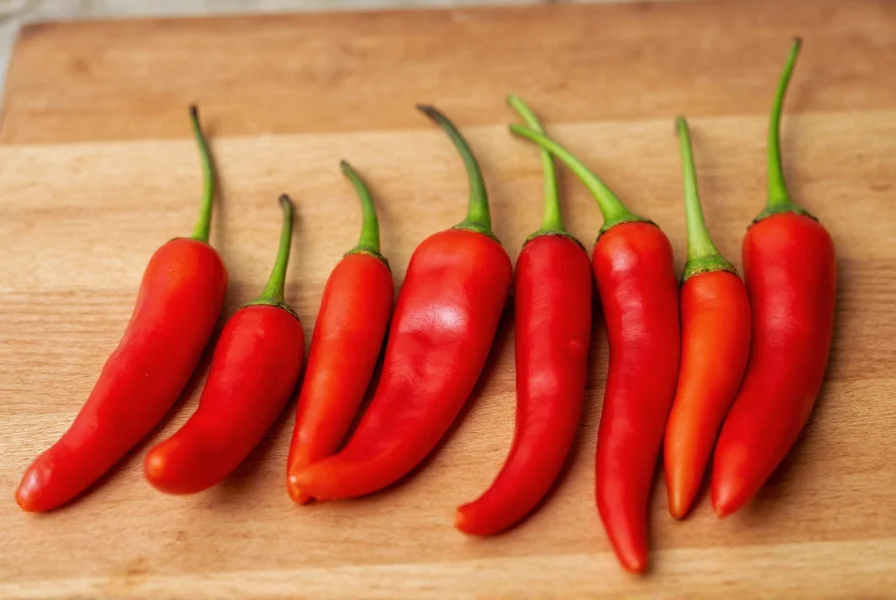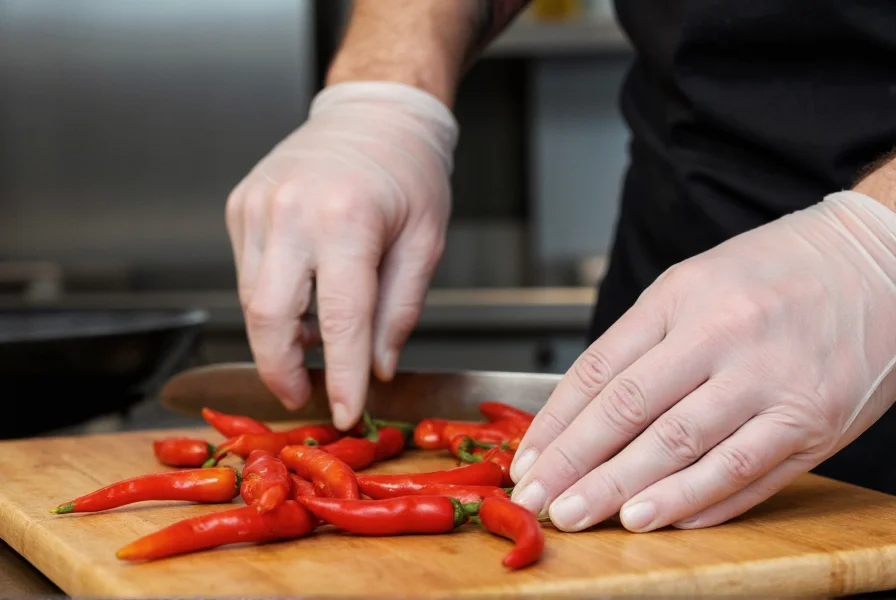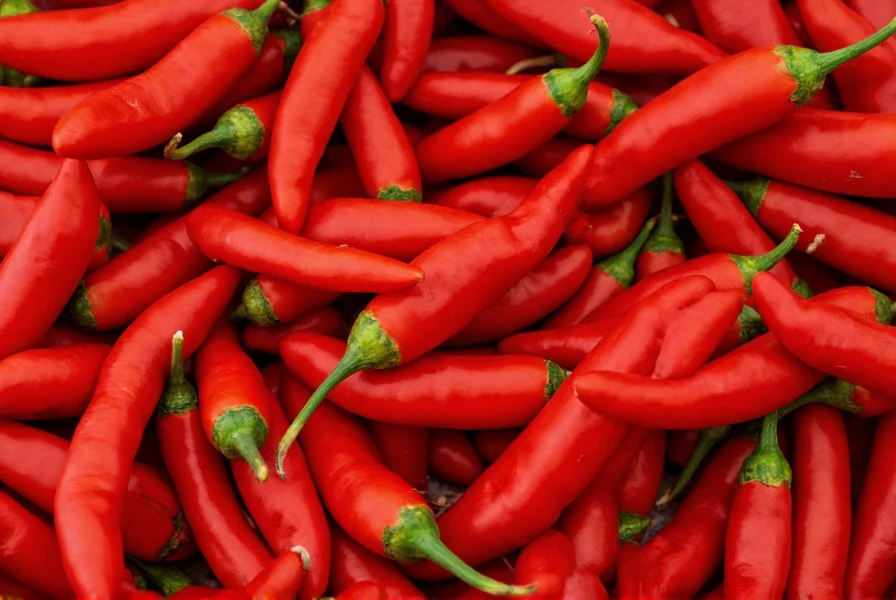When you encounter small red chilies in your local market or recipe, understanding their characteristics is essential for proper culinary application. These vibrant peppers represent the mature stage of various chili cultivars that start green and ripen to brilliant red hues. Their diminutive size belies their powerful impact on dishes, making them a staple ingredient in many global cuisines.
Identifying Common Small Red Chili Varieties
Not all small red chilies are the same. The term encompasses several distinct varieties with unique characteristics:
- Bird's Eye Chili (Thai Chili) - Originating in Southeast Asia, these 1-2 inch peppers range from 50,000-100,000 SHU with a bright, citrusy heat
- Pequín Pepper - Native to Mexico, these 0.5-1 inch chilies measure 30,000-60,000 SHU with a smoky, nutty flavor profile
- Cayenne (when small) - Though often larger, young cayenne peppers can be small and red with 30,000-50,000 SHU
- African Bird's Eye - Similar to Thai chilies but often slightly smaller with comparable heat levels

Understanding Heat Levels and Flavor Profiles
The Scoville scale provides a standardized measurement of chili pepper heat, but small red chilies vary significantly within this category. While bird's eye chilies typically register between 50,000-100,000 Scoville Heat Units (SHU), pequín peppers range from 30,000-60,000 SHU. For context, jalapeños measure only 2,500-8,000 SHU, making small red chilies substantially hotter.
Beyond pure heat, these peppers offer complex flavor notes:
| Variety | Heat Level (SHU) | Flavor Characteristics | Common Culinary Uses |
|---|---|---|---|
| Bird's Eye/Thai | 50,000-100,000 | Citrusy, bright, floral | Thai curries, sambal, Vietnamese dipping sauces |
| Pequín | 30,000-60,000 | Smoky, nutty, earthy | Mexican moles, adobos, pickled preparations |
| African Bird's Eye | 50,000-100,000 | Sharp, clean heat | African stews, peri-peri sauce, marinades |
Practical Culinary Applications
When working with small red chilies in cooking, understanding their behavior is crucial for balanced results. Unlike larger peppers, these compact varieties distribute heat more evenly throughout dishes due to their higher seed-to-flesh ratio. Professional chefs recommend these techniques for optimal use:
- Whole infusion - Add whole chilies to soups, stews, or braises for gradual heat release without overwhelming spiciness
- Finely minced - Incorporate minced chilies early in cooking for dishes requiring even heat distribution
- Seeds and membranes - Remember that capsaicin concentrates in seeds and white membranes; remove these for milder heat while retaining flavor
- Timing matters - Add near the end of cooking for brighter, more pronounced heat; add early for mellower, integrated spiciness
Substitution Guide for Small Red Chilies
When your recipe calls for small red chilies but you don't have them available, consider these substitution options based on the specific variety needed:
- For Thai bird's eye chilies: Use serrano peppers (less intense) or a combination of cayenne and a touch of red pepper flakes
- For pequín peppers: Try crushed Aleppo pepper or a mix of chipotle powder and cayenne for smoky notes
- For general small red chili applications: Red jalapeños provide milder heat while maintaining similar flavor characteristics
When substituting, always start with less than the recipe specifies and adjust to taste, as heat levels vary significantly between varieties and even individual peppers.
Proper Handling and Safety Considerations
Working with small red chilies requires proper handling techniques to avoid discomfort:
- Always wear gloves when handling extremely hot varieties like bird's eye chilies
- Avoid touching your face, especially eyes, during preparation
- Use separate cutting boards for chilies to prevent cross-contamination
- If skin irritation occurs, apply milk or yogurt rather than water (capsaicin is oil-soluble)
- Remove chili oils from surfaces using soapy water or specialized cleaners

Storage Methods for Maximum Freshness
Preserving small red chilies properly extends their usability while maintaining flavor integrity:
- Refrigeration - Store unwashed in perforated plastic bags in the crisper drawer for 2-3 weeks
- Freezing - Freeze whole peppers in airtight containers for up to 6 months (no need to thaw before use)
- Drying - Air-dry or use a food dehydrator to create potent dried chilies for grinding into powder
- Vinegar preservation - Create quick-pickled chilies in vinegar for refrigerator storage up to 3 months
Growing Small Red Chilies at Home
For gardening enthusiasts, cultivating small red chilies is achievable even in limited spaces:
- Start seeds indoors 8-10 weeks before last frost date
- Provide 6-8 hours of direct sunlight daily or use grow lights
- Maintain consistent moisture without waterlogging soil
- Harvest when peppers turn vibrant red and feel firm
- Container gardening works well with 5-gallon pots for most varieties
Conclusion: Maximizing Small Red Chili Potential
Small red chilies represent one of the most versatile and impactful ingredients in global cuisines. Understanding their specific characteristics—heat levels, flavor profiles, and proper handling techniques—allows home cooks and professional chefs alike to harness their full potential. Whether you're preparing authentic Thai curries, Mexican moles, or African stews, selecting the appropriate small red chili variety and using it correctly transforms dishes from ordinary to extraordinary. By following proper storage methods and safety precautions, you can enjoy these potent peppers while minimizing waste and maximizing culinary success.
Frequently Asked Questions
Are small red chilies the same as bird's eye chilies?
Not exactly. Bird's eye chilies are one specific variety of small red chili, but the term "small red chili" encompasses multiple varieties including pequín peppers, some Thai chilies, and African bird's eye peppers. While all bird's eye chilies are small red chilies when mature, not all small red chilies are bird's eye varieties.
How can I reduce the heat of small red chilies in a dish?
To reduce heat from small red chilies, remove the seeds and white membranes where capsaicin concentrates. Adding dairy products like yogurt or coconut milk, acidic components like lime juice, or sweet elements can also balance excessive heat. Remember that heat intensifies during cooking, so add small red chilies gradually and taste as you go.
What's the difference between fresh and dried small red chilies?
Fresh small red chilies offer brighter, more floral notes with immediate heat, while dried versions develop deeper, smokier flavors with more concentrated but slightly different heat characteristics. Dried chilies typically require rehydration before use in most applications, except when making powders or infusing oils. The drying process concentrates flavors but can alter the heat profile slightly.
Can I substitute red pepper flakes for small red chilies?
Yes, but with caution. Red pepper flakes provide similar heat but lack the fresh flavor complexity of whole small red chilies. Use approximately 1/4 teaspoon of red pepper flakes for each small red chili called for in a recipe, then adjust to taste. For better flavor matching, combine red pepper flakes with a touch of smoked paprika when substituting for pequín peppers, or with a hint of citrus zest for Thai bird's eye chilies.
Why do some small red chilies taste fruitier than others?
The fruitiness in small red chilies comes from their specific variety and ripeness. Thai bird's eye chilies often have citrusy, almost tropical notes when fully ripe, while pequín peppers develop nutty, earthy characteristics. Growing conditions, soil composition, and harvest timing also influence flavor development. Fully ripened red chilies generally taste fruitier than their green counterparts due to sugar development during the ripening process.











 浙公网安备
33010002000092号
浙公网安备
33010002000092号 浙B2-20120091-4
浙B2-20120091-4